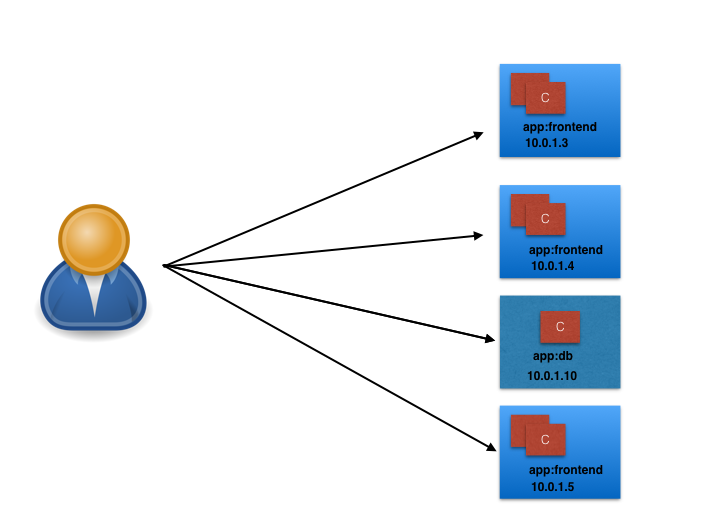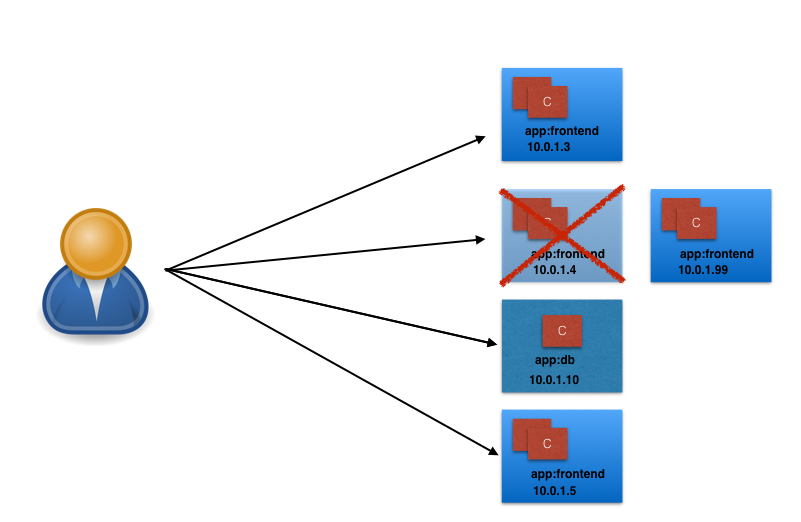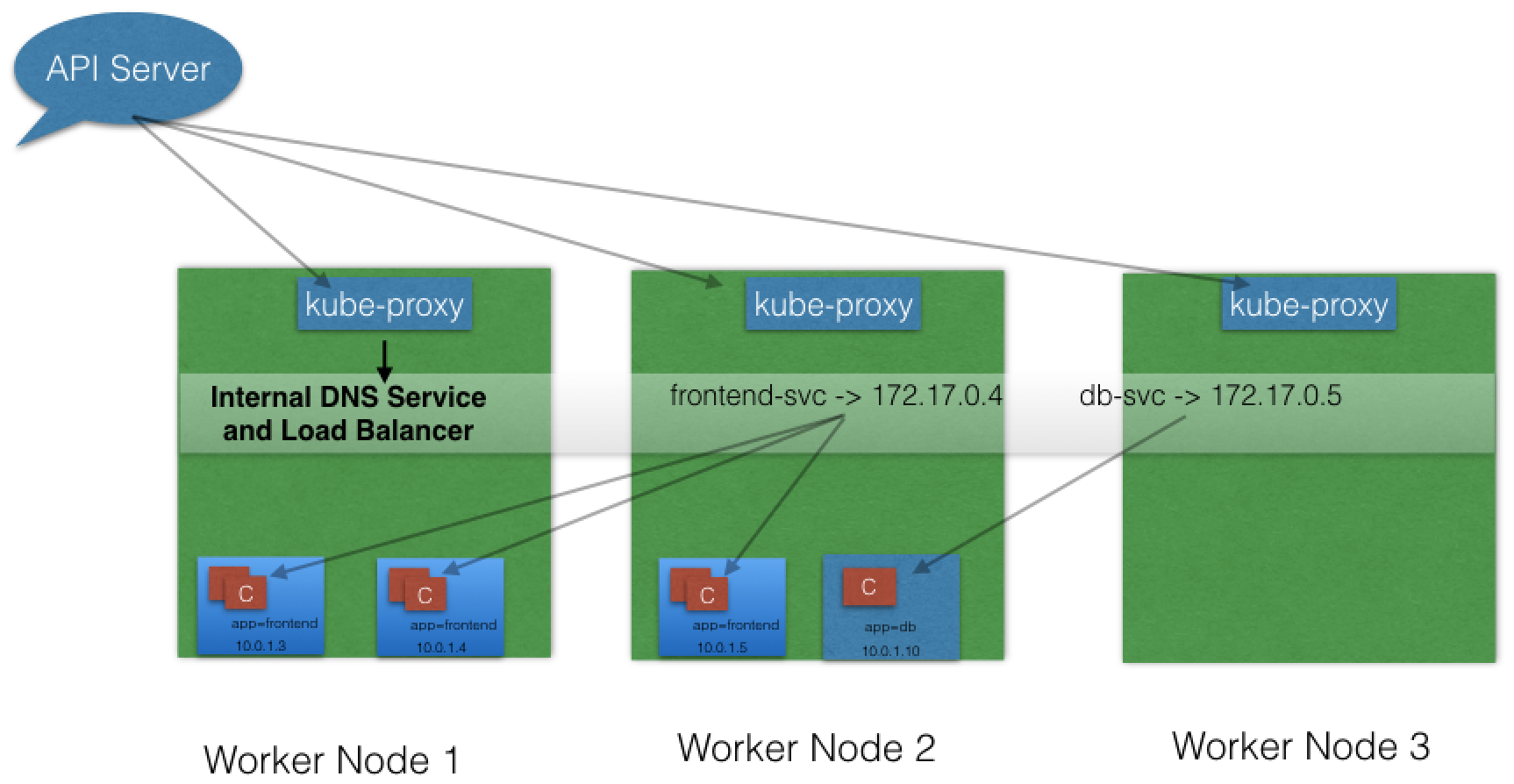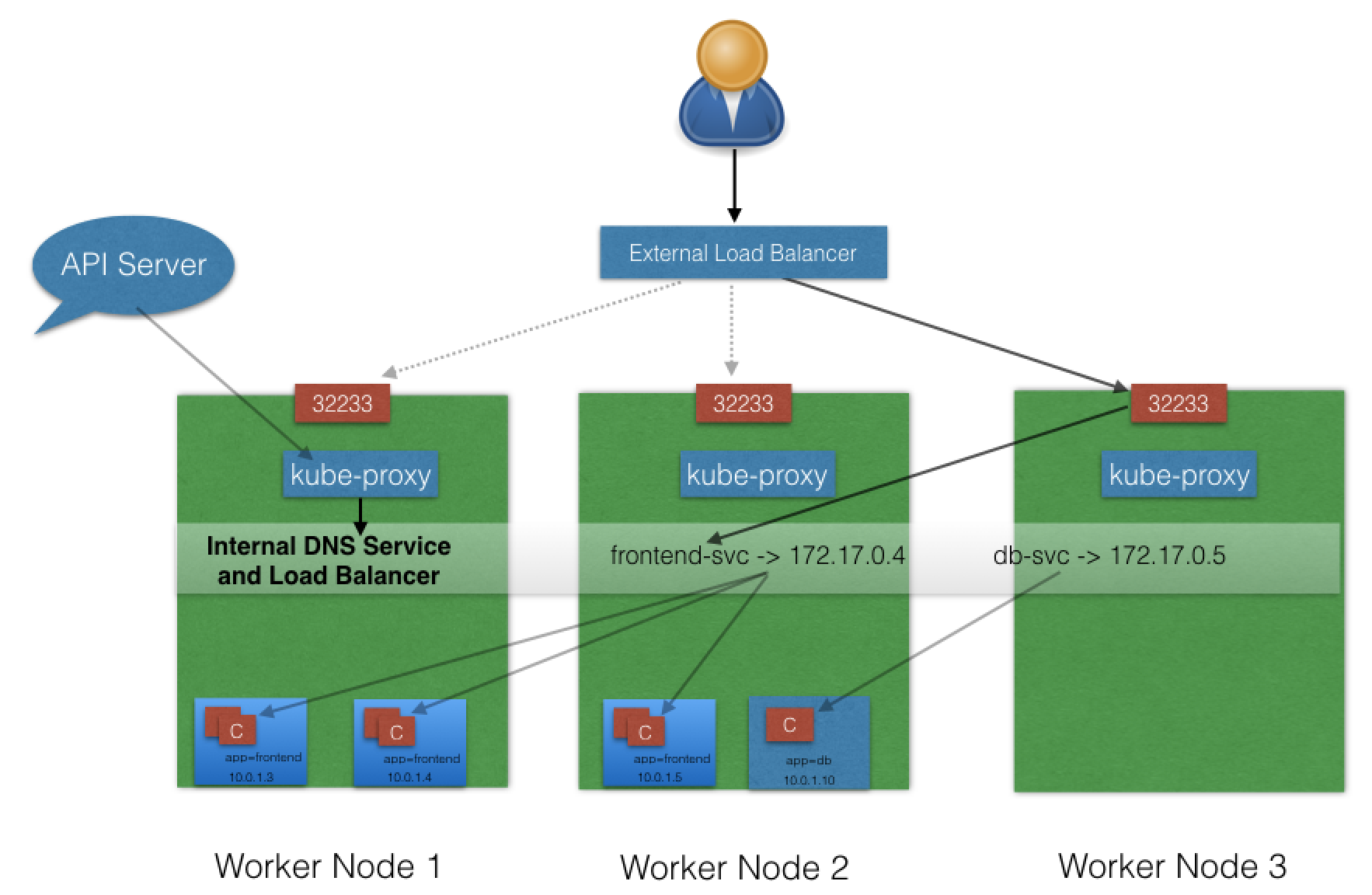Services
Introduction
- Although the microservices driven architecture aims to decouple the components of an application, microservices still need agents to logically tie or group them together for management purposes, or to load balance traffic to the ones that are part of such a logical set.
- In this chapter, we will learn about Service objects used to abstract the communication between cluster internal microservices, or with the external world. A Service offers a single DNS entry for a containerized application managed by the Kubernetes cluster, regardless of the number of replicas, by providing a common load balancing access point to a set of pods logically grouped and managed by a controller such as a Deployment, ReplicaSet, or DaemonSet.
- We will also learn about the
kube-proxydaemon, which runs on each control plane and worker node to implement the services' configuration and to provide access to services. In addition we will discussservice discoveryandservice types, which decide the access scope of a service.
Connecting Users or Applications to Pods
- To access the application, a user or another application need to connect to the Pods. As Pods are ephemeral in nature, resources like IP addresses allocated to them cannot be static. Pods could be terminated abruptly or be rescheduled based on existing requirements.
- Let’s take, for example, a scenario where an operator manages a set of Pods and a user/client is accessing the Pods directly by using their individual IP addresses.

- Unexpectedly, one of the Pods the user/client is accessing is terminated, and a new Pod is created by the controller. The new Pod will have a new IP address, that will not be immediately known by the user/client.

- To overcome this situation, Kubernetes provides a higher-level abstraction called
Service, which logically groups Pods and defines a policy to access them. This grouping is achieved viaLabelsandSelectors.
Services
- Labels and Selectors use a key-value pair format. In the following graphical representation, app is the Label key, frontend and db are Label values for different Pods.

- Using the selectors app==frontend and app==db, we group Pods into two logical sets: one set with 3 Pods, and one set with a single Pod.
- We assign a name to the logical grouping, referred to as a Service. The Service name also is registered with the cluster’s internal DNS service. In our example, we create two Services, frontend-svc, and db-svc, and they have the app==frontend and the app==db Selectors, respectively.
- Services can expose single Pods, ReplicaSets, Deployments, DaemonSets, and StatefulSets. When exposing the Pods managed by an operator, the Service’s Selector may use the same label(s) as the operator.
Service Object Example
- The following is an example of a Service object definition:
apiVersion: v1
kind: Service
metadata:
name: frontend-svc
spec:
selector:
app: frontend
ports:
- protocol: TCP
port: 80
targetPort: 5000
- In above example, we are creating a frontend-svc Service by selecting all the Pods that have the Label key=app set to value=frontend.
- By default, each Service receives an IP address routable only inside the cluster, known as ClusterIP.
- In our example, we have
172.17.0.4and172.17.0.5as ClusterIPs assigned to ourfrontend-svcanddb-svcServices, respectively.

- The user/client now connects to a Service via its ClusterIP, which forwards traffic to one of the Pods attached to it.
- A Service provides load balancing by default while selecting the Pods for traffic forwarding.
- While the Service forwards traffic to Pods, we can select the
targetPorton the Pod which receives the traffic. - In our example, the
frontend-svcService receives requests from the user/client onport: 80and then forwards these requests to one of the attached Pods on thetargetPort: 5000. - If the
targetPortis not defined explicitly, then traffic will be forwarded to Pods on the port on which the Service receives traffic. - It is very important to ensure that the value of the
targetPort, which is5000in this example, matches the value of the containerPort property of the Pod spec section. - A logical set of a Pod’s IP address, along with the
targetPortis referred to as a Service endpoint. - In our example, the
frontend-svcService has 3 endpoints:10.0.1.3:5000,10.0.1.4:5000, and10.0.1.5:5000. Endpoints are created and managed automatically by the Service, not by the Kubernetes cluster administrator.
kube-proxy
- Each cluster node runs a daemon called
kube-proxy, a node agent that watches the API server on the master node for the addition, updates, and removal of Services and endpoints. kube-proxyis responsible for implementing the Service configuration on behalf of an administrator or developer, in order to enable traffic routing to an exposed application running in Pods.- In the example below, for each new Service, on each node,
kube-proxyconfigures iptables rules to capture the traffic for its ClusterIP and forwards it to one of the Service’s endpoints. - Therefore any node can receive the external traffic and then route it internally in the cluster based on the iptables rules.
- When the Service is removed, kube-proxy removes the corresponding iptables rules on all nodes as well.

Traffic Policies
- The
kube-proxynode agent together with the iptables implement the load-balancing mechanism of the Service when traffic is being routed to the application Endpoints. - Due to restricting characteristics of the iptables this load-balancing is random by default. This means that the Endpoint Pod to receive the request forwarded by the Service will be randomly selected out of many replicas.
- This mechanism does not guarantee that the selected receiving Pod is the closest or even on the same node as the requester, therefore not the most efficient mechanism.
- Since this is the iptables supported load-balancing mechanism, if we desire better outcomes, we would need to take advantage of traffic policies.
- Traffic policies allow users to instruct the
kube-proxyon the context of the traffic routing. The two options areClusterandLocal:
- The Cluster option allows
kube-proxyto target all ready Endpoints of the Service in the load-balancing process.- The Local option, however, isolates the load-balancing process to only include the Endpoints of the Service located on the same node as the requester Pod. While this sounds like an ideal option, it does have a shortcoming - if the Service does not have a ready Endpoint on the node where the requester Pod is running, the Service will not route the request to Endpoints on other nodes to satisfy the request.
- Both the
ClusterandLocaloptions are available for requests generated internally from within the cluster, or externally from applications and clients running outside the cluster.
Service Discovery
- As Services are the primary mode of communication between containerized applications managed by Kubernetes, it is helpful to be able to discover them at runtime. Kubernetes supports two methods for discovering Services:
Environment Variables
- As soon as the Pod starts on any worker node, the
kubeletdaemon running on that node adds a set of environment variables in the Pod for all active Services. - For example, if we have an active Service called
redis-master, which exposes port6379, and its ClusterIP is172.17.0.6, then, on a newly created Pod, we can see the following environment variables:
REDIS_MASTER_SERVICE_HOST=172.17.0.6
REDIS_MASTER_SERVICE_PORT=6379
REDIS_MASTER_PORT=tcp://172.17.0.6:6379
REDIS_MASTER_PORT_6379_TCP=tcp://172.17.0.6:6379
REDIS_MASTER_PORT_6379_TCP_PROTO=tcp
REDIS_MASTER_PORT_6379_TCP_PORT=6379
REDIS_MASTER_PORT_6379_TCP_ADDR=172.17.0.6
- With this solution, we need to be careful while ordering our Services, as the Pods will not have the environment variables set for Services which are created after the Pods are created.
DNS
- Kubernetes has an add-on for DNS, which creates a DNS record for each Service and its format is
my-svc.my-namespace.svc.cluster.local. - Services within the same Namespace find other Services just by their names.
- If we add a Service
redis-masterinmy-nsNamespace, all Pods in the samemy-nsNamespace lookup the Service just by its name,redis-master. Pods from other Namespaces, such astest-ns, lookup the same Service by adding the respective Namespace as a suffix, such asredis-master.my-nsor providing the FQDN of the service asredis-master.my-ns.svc.cluster.local. - This is the most common and highly recommended solution.
- For example, in the previous section’s image, we have seen that an internal DNS is configured, which maps our Services
frontend-svcanddb-svcto172.17.0.4and172.17.0.5IP addresses respectively.
ServiceType
While defining a Service, we can also choose its access scope. We can decide whether the Service:
- Is only accessible within the cluster.
- Is accessible from within the cluster and the external world.
- Maps to an entity which resides either inside or outside the cluster. Access scope is decided by ServiceType property, defined when creating the Service.
ServiceType: ClusterIP and NodePort
- ClusterIP is the default ServiceType. A Service receives a Virtual IP address, known as its ClusterIP. This Virtual IP address is used for communicating with the Service and is accessible only from within the cluster.
- With the NodePort ServiceType, in addition to a ClusterIP, a high-port, dynamically picked from the default range
30000-32767, is mapped to the respective Service, from all the worker nodes. - For example, if the mapped
NodePortis32233for the servicefrontend-svc, then, if we connect to any worker node on port32233, the node would redirect all the traffic to the assigned ClusterIP -172.17.0.4. - If we prefer a specific high-port number instead, then we can assign that high-port number to the NodePort from the default range when creating the Service.

- The NodePort ServiceType is useful when we want to make our Services accessible from the external world.
- The end-user connects to any worker node on the specified high-port, which proxies the request internally to the ClusterIP of the Service, then the request is forwarded to the applications running inside the cluster.
- Let’s not forget that the Service is load balancing such requests, and only forwards the request to one of the Pods running the desired application.
- To manage access to multiple application Services from the external world, administrators can configure a reverse proxy - an ingress, and define rules that target specific Services within the cluster.
ClusterIP and NodePort Service Types (Demo)
ServiceType: LoadBalancer
With the LoadBalancer ServiceType:
NodePortandClusterIPare automatically created, and the external load balancer will route to them.- The Service is exposed at a static port on each worker node.
- The Service is exposed externally using the underlying cloud provider’s load balancer feature.

- The LoadBalancer ServiceType will only work if the underlying infrastructure supports the automatic creation of Load Balancers and have the respective support in Kubernetes, as is the case with the Google Cloud Platform and AWS. If no such feature is configured, the LoadBalancer IP address field is not populated, it remains in Pending state, but the Service will still work as a typical NodePort type Service.
ServiceType: ExternalIP
- A Service can be mapped to an ExternalIP address if it can route to one or more of the worker nodes.
- Traffic that is ingressed into the cluster with the ExternalIP (as destination IP) on the Service port, gets routed to one of the Service endpoints. This type of service requires an external cloud provider such as Google Cloud Platform or AWS and a Load Balancer configured on the cloud provider’s infrastructure.
- Please note that ExternalIPs are not managed by Kubernetes. The cluster administrator has to configure the routing which maps the ExternalIP address to one of the nodes.
ServiceType: ExternalName
- ExternalName is a special ServiceType, that has no Selectors and does not define any endpoints.
- When accessed within the cluster, it returns a CNAME record of an externally configured Service.
- The primary use case of this ServiceType is to make externally configured Services like
my-database.example.comavailable to applications inside the cluster. - If the externally defined Service resides within the same Namespace, using just the name
my-databasewould make it available to other applications and Services within that same Namespace.
Multi-Port Services
- A Service resource can expose multiple ports at the same time if required.
- Its configuration is flexible enough to allow for multiple groupings of ports to be defined in the manifest.
- This is a helpful feature when exposing Pods with one container listening on more than one port, or when exposing Pods with multiple containers listening on one or more ports.
- A multi-port Service manifest is provided below:
apiVersion: v1
kind: Service
metadata:
name: my-service
spec:
selector:
app: myapp
type: NodePort
ports:
- name: http
protocol: TCP
port: 8080
targetPort: 80
nodePort: 31080
- name: https
protocol: TCP
port: 8443
targetPort: 443
nodePort: 31443
- The
my-serviceService resource exposes Pods labeledapp==myappwith possibly one container listening on ports80and443, as described by the twotargetPortfields. - The Service will be visible inside the cluster on its ClusterIP and ports
8080and8443as described by the two port fields, and it will also be accessible to incoming requests from outside the cluster on the two nodePort fields31080and31443. - When manifests describe multiple ports, they need to be named as well, for clarity, as described by the two name fields with values
httpandhttpsrespectively. - This Service is configured to capture traffic on ports
8080and8443from within the cluster, or on ports31080and31443from outside the cluster, and forward that traffic to the ports80and443respectively of the Pods running the container.
Learning Objectives (Review)
By the end of this chapter, you should be able to:
- Discuss the benefits of logically grouping Pods with Services to access an application.
- Explain the role of the
kube-proxydaemon running on each node. - Explore the Service discovery options available in Kubernetes.
- Discuss different Service types.
